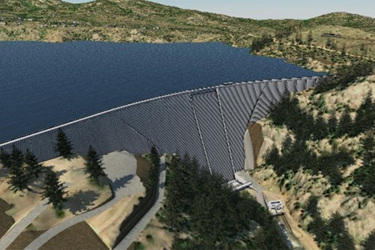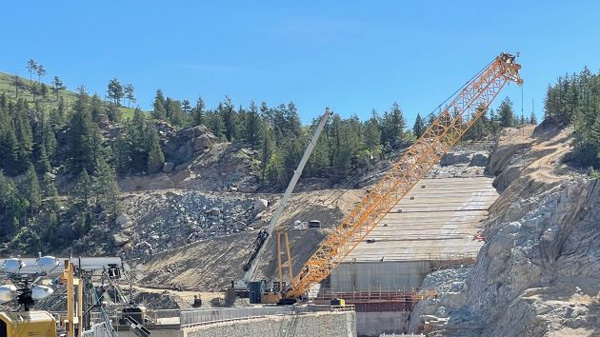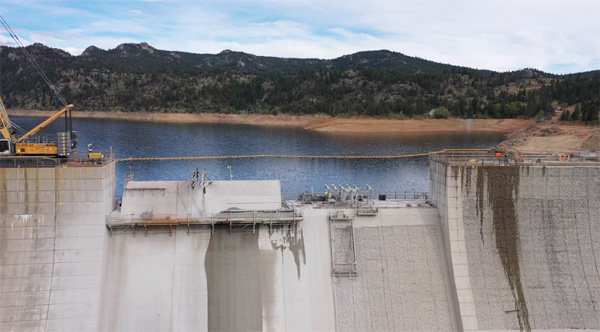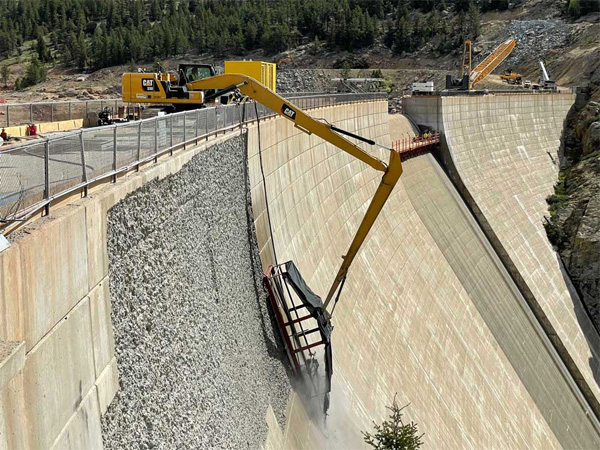Why Denver Water Is Raising Gross Dam
By Ann Baker

Substantial progress made on Gross Reservoir Expansion Project to ease Denver’s storage imbalance.
When Denver Water’s Jeff Martin opens a staff meeting with an icebreaker, he tells colleagues about the 2,000-year-old Cornalvo Dam in Spain.
Though ancient Romans built the earthen dam, it has withstood the test of time and continues to serve the region with crucial drinking water to this day.
“It’s still useful infrastructure,” said Martin, the program manager for Denver Water’s Gross Reservoir Expansion Project, a massive effort to help ease a storage imbalance in the utility’s water collection system.
“What we do, the importance of what we’re building, has to provide a human benefit, a benefit to society for many, many years to come.”
In April 2022, Denver Water began construction on the project, which will nearly triple the capacity of Gross Reservoir. Named for the utility’s former chief engineer Dwight D. Gross, the dam will be raised by 131 feet. At 471 feet tall when complete, it’ll be the tallest dam in Colorado.
Preparation and permitting for the construction project was in the works for two decades, though the original engineers in the 1950s had designed it to be raised twice, if needed. Construction has entered its second year, as work continues to ready the site for concrete placement and the dam raise scheduled to begin next year in 2024.
Denver Water says the expanded reservoir is needed now, as Colorado faces an era of more intense droughts, heavier rain events, and earlier snowmelt, all driven by climate change.
“The 1.5 million people who rely on Denver Water depend on a resilient, balanced system,” Martin said.
Right now, 90% of Denver’s water storage capacity is on the south side of its system and only 10% is on the north, where Gross Dam is located. Raising the dam will help correct that imbalance, giving the utility more flexibility if there’s a problem on the south side, such as operational issues, wildfires, drought, or other system upsets or emergencies.
“A vibrant Denver is extremely important not just for Denver and the people we provide water to, but to Colorado as a whole,” Martin said. “We have to make sure we can provide water resiliency and protect the water resources of the West. It’s really a relief to see this project progressing.”

The new abutments, or sides of the dam, have been clawed out of the hillsides on both sides of the existing dam, exposing the rock that will become the foundation of the larger, higher dam. Photo credit: Denver Water.
Environmental Benefits
The National Environmental Policy Act process required Denver Water to evaluate hundreds of options to meet this imbalance challenge before concluding that expanding Gross Reservoir was the least environmentally damaging.
Denver Water will use its existing water rights on the west side of the Continental Divide to fill the expanded reservoir during average and above-average water years.
Because of its statewide impacts, Denver Water approached the project with a cooperative objective.
The utility spent years collaborating with dozens of entities, including counties on both sides of the state, environmental organizations, and elected officials, to develop an enhancement plan that would improve watersheds impacted by the expanded reservoir.
Expanding Gross Dam will provide an additional 72,000 acre-feet of water storage in the reservoir.
Of that, 5,000 acre-feet of storage space in the expanded reservoir — known as the environmental pool — will provide beneficial stream flows along a 17-mile stretch of South Boulder Creek below the dam during dry periods to protect fish and aquatic insects.
Denver Water also committed more than $30 million to more than 60 environmental mitigation and enhancement projects throughout the state, including habitat restoration, greenback cutthroat trout recovery, long-term water quality monitoring, and more.

In 2022, Construction crews removed the spillway crest on the top of Gross Dam to make way for new concrete when the dam is raised starting in 2024. In this picture, the right side has been removed and crews were using a wire saw to cut the left half into smaller pieces for removal. Photo credit: Denver Water.
“From the beginning, we said we’re going to tackle this differently than we have in the past,” Martin said. “Denver Water strives to be a water resource leader for Colorado and the West. To be a leader, we have to be stewards of the environment and work with other stakeholders.”
That extra work and emphasis on environmental stewardship is paying off, Martin said, putting Denver Water in a better position to protect water resources and collaborate on broader Colorado River issues.
“In the end, this project won’t be judged by whether we raised the dam,” said Denver Water’s CEO Jim Lochhead in 2021 after the utility received final project permits, “but rather how we went about expanding the reservoir.”
Construction Underway
There are several aspects that make this project trickier than others.
For one, Denver Water must continue to send water through the dam during construction. The remote location also presented a challenge to maneuvering large pieces of construction equipment into place. And the project must balance recreational needs with necessary construction closures to ensure the safety of both the public and workers.
On top of all that, adding roller-compacted concrete to an existing dam hasn’t been done in the United States for at least 50 years, requiring designers to combine modern engineering knowledge with lessons derived from ancient Romans about building arch-shaped dams, Martin said.
“We’ve struck a great balance,” Martin said. “It’s a robust structure, very innovative.
And the project, which involves about 200 workers onsite on any given day (a number that will grow to about 450 people at the peak of construction work), has hit several significant construction milestones since work started in April 2022.
- The new abutments, or sides of the dam, have been clawed out of the hillsides on both sides of the existing dam, exposing the rock that will become the foundation of the larger, higher dam. The process excavated about 200,000 cubic yards of rock.
- About 200,000 square feet of concrete on the surface of the existing dam was roughed up last summer and fall by a hydrodemolition process that used a stream of water under high pressure to blast away the top 2-to-3 inches of concrete — and give the new concrete a rough surface to adhere to.
- The existing dam’s 160-foot-wide spillway crest is gone — sawed away last summer and fall by crews wielding diamond-studded wires to slice through the thick concrete as if it was a block of cheese.
- Work has begun on digging the onsite quarry that will supply rock for the on-site concrete batch plant, which also is under construction. About 1 million cubic yards of earth will be moved to create all of the facilities and offices needed for the project.
- To improve safety for residents, visitors, and workers, improvements to the intersection of Highway 72 and Gross Dam Road, as well as along Gross Dam Road from that intersection to Flagstaff Road were planned. The new alignment of the intersection opened in June and roadway improvements are ongoing.
- Recreation facilities were improved on the north side of the reservoir to replace the facilities in the construction area, including expanding the parking lot, improving the picnic areas and trail, and implementing a shuttle to bring recreators and their watercraft down to the water.

In 2022, hydrodemolition work at Gross Dam roughened up about 200,000 square feet of concrete on the face of the dam, work that will help the new concrete to adhere to the face of the dam when it’s applied. Photo credit: Denver Water.
Next year, in 2024, crews will start adding new concrete at the bottom of the dam and extend the base of the dam outward. Then they’ll add concrete steps up to the dam’s new height.
Denver Water expects construction to be complete in 2027, meeting the deadline imposed on the project by the Federal Energy Regulatory Commission.
Martin praised Denver Water’s dedicated staff and leadership, many of whom have spent their entire careers on this project, for steering such a crucial project to construction.
“We embraced environmental stewardship early on,” he said. “We knew it was important to build a world-class project in a world-class way.”
